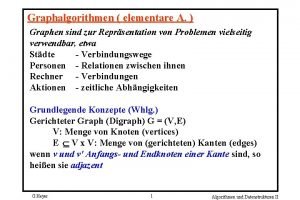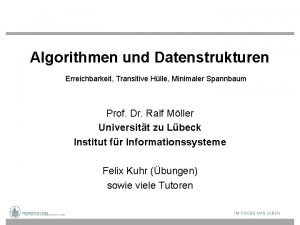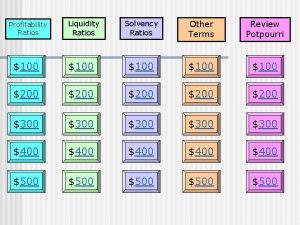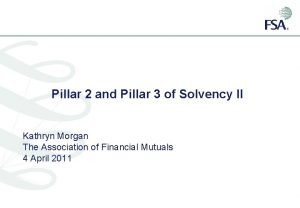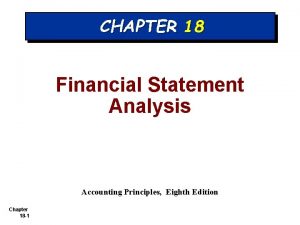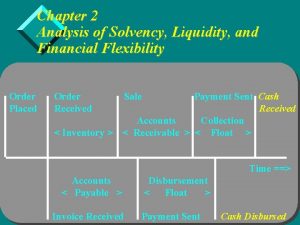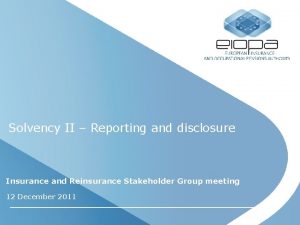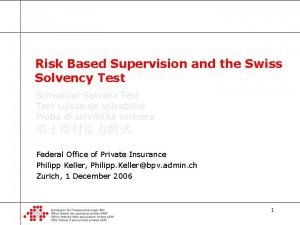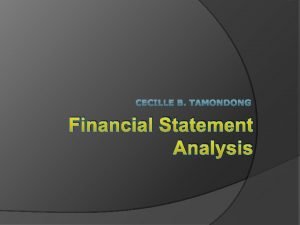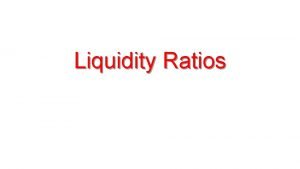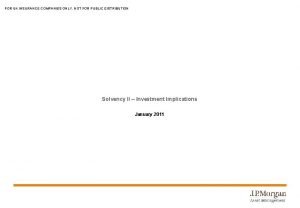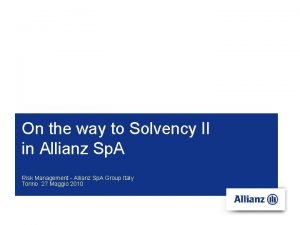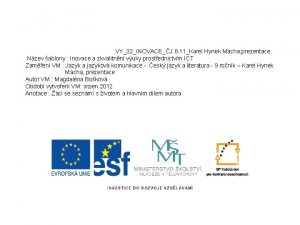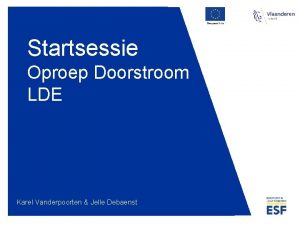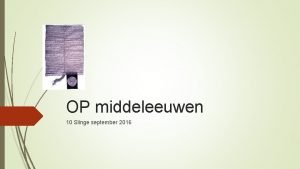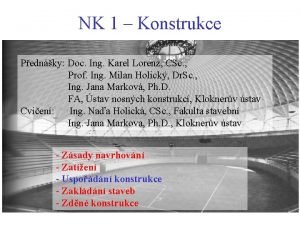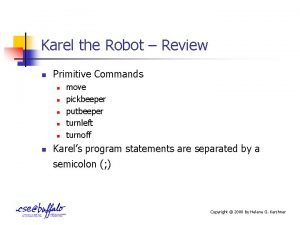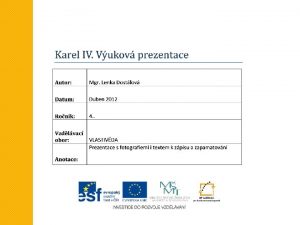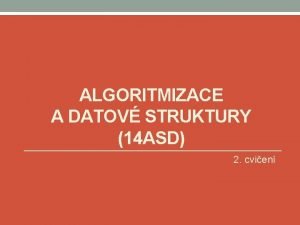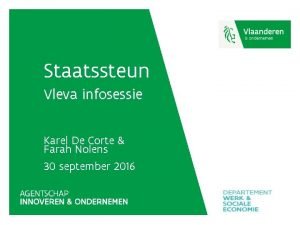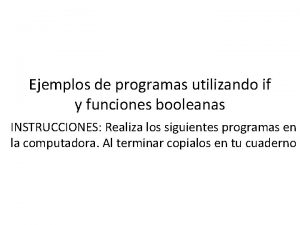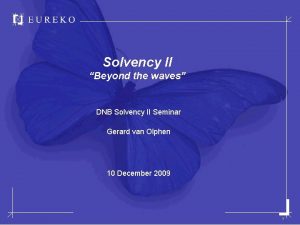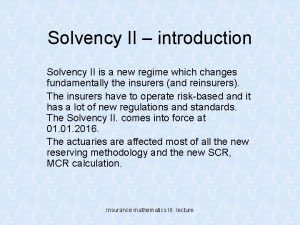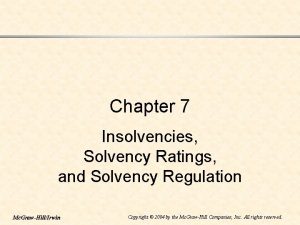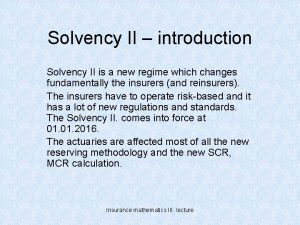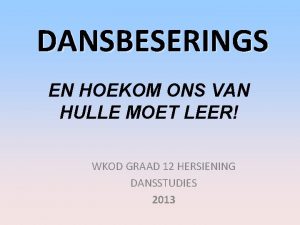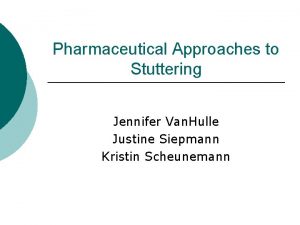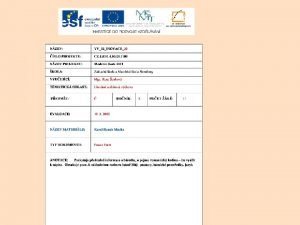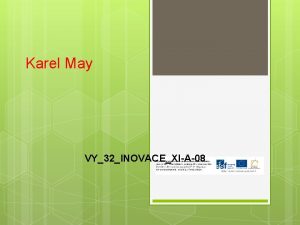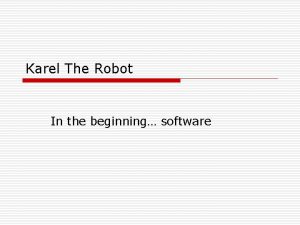Principles of Solvency II Prof Karel Van Hulle















































- Slides: 47

Principles of Solvency II Prof. Karel Van Hulle KU Leuven and Goethe University Frankfurt Member IRSG – EIOPA Financial Supervision Commission Sofia, 12 September 2017

Insurance regulation under Solvency I • Was boring: very difficult to explain to an outsider how to • • calculate the solvency margin under Solvency I Insurance regulation was highly prescriptive and paternalistic Insurance regulation was very legalistic and did not reflect the economics of the insurance business model Insurance regulation was more concerned with policyholder protection than with insurance Insurance supervisors were considered less important or qualified than their banking colleagues Prof. Karel Van Hulle - KU Leuven and Goethe University Frankfurt 2

Insurance supervision under Solvency I • Insurance supervision was often limited to a detailed • • scrutiny of a number of forms Form over substance – tick the box exercise Insurance supervisors rarely engaged directly with supervised entities Insurance supervisors rarely had direct market experience: employment moves between supervision and industry or vice versa were often seen as suspect Insurance supervisors preferred detailed rules rather than a principles based approach, requiring judgment Prof. Karel Van Hulle - KU Leuven and Goethe University Frankfurt 3

The birth of Solvency II • For the EU, Solvency II is the most important change in insurance regulation since the last 30 years • The birth of Solvency II was very much helped by the capital market crisis at the beginning of this century • Crucial elements of Solvency II are: o The introduction of an economic risk based approach o The linkage between risk and capital o The crucial role to be played by risk management • The need to move in the direction of a risk based solvency capital regime is now recognised throughout the world Prof. Karel Van Hulle - KU Leuven and Goethe University Frankfurt 4

Why Solvency II? • Solvency I as designed in the 70’s was not sufficiently risk • • • based Solvency I did not encourage insurers to better manage their risks Solvency I did not attach sufficient importance to the qualitative aspects of supervision Solvency I did not include an early warning signal Solvency I did not attach sufficient importance to group supervision Solvency I did not take account of progress in banking, accounting, actuarial science Prof. Karel Van Hulle - KU Leuven and Goethe University Frankfurt 5

Other reasons • After 30 years, it was time to modernize the regulatory • • framework for insurance Action was needed before the Solvency I regime would break down because of a changed environment A more efficient allocation of capital would allow the insurance industry to take on more risks Supervisory convergence could only come about when moving away from minimum harmonization Recent changes in banking regulation could produce regulatory arbitrage inciting insurers to engage in more risky behaviour Prof. Karel Van Hulle - KU Leuven and Goethe University Frankfurt 6

How was Solvency II developed? • Adoption of Framework for Consultation setting the basic • • principles of Solvency II Calls for Advice by EC to CEIOPS (three waves) Proposed Directive (10 July 2017) with extensive impact assessment and cost/benefit analysis Field testing: quantitative impact assessments Extensive dialogue and consultation with: o Insurance sector (CEA, AMICE, CRO & CFO Forum) o Actuarial profession (Groupe Consultatif) o Insurance supervisors (CEIOPS) o Member States (EIOPC) Prof. Karel Van Hulle - KU Leuven and Goethe University Frankfurt 7

Initial timetable 2006 2007 Directive development (Commission) 2008 2009 Directive adoption (Council & Parliament) 2010 2011 2012 Implementation (Member states) CEIOPS work on technical advice necessary for implementing measures / supervisory convergence / preparation for implementation / training & development Adoption of implementing measures Commission preparatory work implementing measures July 2007 Proposed Solvency II Directive published QIS 2 QIS 3 October 2012 Solvency II enters into force QIS 4 Prof. Karel Van Hulle - KU Leuven and Goethe University Frankfurt QIS 5 8

Lamfalussy approach • Framework Directive replacing all existing Insurance • • Directives with the exception of motor insurance, accounting and financial conglomerates, i. e. principles based approach Implementation of the Framework Directive by the European Commission (level 2) Further development by supervisors (CEIOPS, now EIOPA) (level 3) Enforcement by the European Commission Solvency II Framework Directive: Directive 2009/138/EC of 25 November 2009 Prof. Karel Van Hulle - KU Leuven and Goethe University Frankfurt 9

Principle objectives of Solvency II • Deepen the Single Market • Enhance policyholder protection and financial stability • Improve (international) competitiveness of EU insurers • Further better regulation Prof. Karel Van Hulle - KU Leuven and Goethe University Frankfurt 10

Ways and means to achieve this • Establishment of risk sensitive capital requirements to encourage and reward good risk management • Emphasis on the responsibility of senior management to manage their business responsibly • Fostering of greater supervisory convergence • Institution of a regular dialogue between supervisor and supervised entities Prof. Karel Van Hulle - KU Leuven and Goethe University Frankfurt 11

Solvency II: 3 pillars and a roof Group supervision & cross-sectoral convergence Groups are recognised as an economic entity => supervision on a consolidated basis (diversification benefits, group risks) Pillar 1: quantitative requirements 1. Harmonised calculation of technical provisions 2. "Prudent person" approach to investments instead of current quantitative restrictions 3. Two capital requirements: the Solvency Capital Requirement (SCR) and the Minimum Capital Requirement (MCR) Prof. Karel Van Hulle - KU Leuven and Goethe University Frankfurt Pillar 2: qualitative requirements and supervision 1. Enhanced governance, internal control, risk management and own risk and solvency assessment (ORSA) 2. Strengthened supervisory review, harmonised supervisory standards and practices 12 Pillar 3: prudential reporting and public disclosure 1. Common supervisory reporting 2. Public disclosure of the financial condition and solvency report (market discipline through transparency)

Pillar I: Quantitative Requirements • Market consistent valuation (fair value) of assets and • • • liabilities Total balance sheet approach Two capital requirements: SCR with confidence level of 99. 5% Va. R over a one year time horizon and MCR with absolute floor Possibility to calculate the SCR using an internal model (full or partial) approved by the supervisor No lists of eligible assets or limits on investments (Prudent Person Rule) Credit for risk mitigation (securitisation, derivatives, reinsurance) and for diversification Prof. Karel Van Hulle - KU Leuven and Goethe University Frankfurt 13

Capital and technical provisions • What is capital in an insurance undertaking? How to deal with long term liabilities? • Market consistent valuation of technical provisions: best estimate and risk margin (based on cost of capital) • Efficient allocation of capital o Two capital requirements with supervisory ladder of intervention o SCR is target level of capital: no need to provide for excessive capital (breach of SCR = invite for cup of tea) o Capital is only one of the measures to ensure the solvency Prof. Karel Van Hulle - KU Leuven and Goethe University Frankfurt 14

Pillar II: Qualitative Requirements • Qualitative requirements to cover risks which are not covered in the SCR • Enhanced internal control, governance and risk management, as well as self-assessment of capital needs (ORSA) with a forward looking approach • Strengthened supervisory review, harmonised supervisory standards and practices Prof. Karel Van Hulle - KU Leuven and Goethe University Frankfurt 15

General governance requirements • From implicit to explicit governance • Effective system providing for sound and prudent • • • management Adequate and transparent organisational structure Clear allocation and appropriate segregation of responsibilities Effective system for ensuring transmission of information Proportionality principle Persons in charge of key functions, members of the Board and persons effectively running the business must be fit and proper Prof. Karel Van Hulle - KU Leuven and Goethe University Frankfurt 16

Governance functions • General principles Written policy o Prior approval by the Board o Regular review (annually or in case of significant changes) • Key functions o Risk management o Internal control and compliance o Internal audit o Actuarial o Prof. Karel Van Hulle - KU Leuven and Goethe University Frankfurt 17

Objectives of the ORSA • ORSA should ensure that an insurer does not engage in business for which it does not have sufficient capital • ORSA should allow an insurer to assess the quality and quantity of financial resources available to it, relative to its needs o o NO SEPARATE CONSIDERATION OF RISK AND CAPITAL ORSA IS THE DNA OF AN INSURANCE UNDERTAKING Prof. Karel Van Hulle - KU Leuven and Goethe University Frankfurt 18

What should ORSA be? • A continuous process to ensure that risk and solvency are key factors in the insurer’s decision making • A key component of an insurer’s risk management culture • A project that is supported by all key stakeholders, based on a clear plan and a clear allocation of responsibilities Prof. Karel Van Hulle - KU Leuven and Goethe University Frankfurt 19

What should ORSA not be? • ORSA should not become a compliance reporting exercise (no box ticking) • ORSA should not be performed solely for the benefit of the supervisor • ORSA should not be seen or be used as a new capital requirement • ORSA should not replace regulatory capital requirements Prof. Karel Van Hulle - KU Leuven and Goethe University Frankfurt 20

Pillar III: Disclosure & Reporting • Public disclosure and Supervisory Reporting • New approach in Pillar 1 and Pillar 2 means new approach needed for Pillar 3! • More freedom for firms to run themselves; but with new responsibilities new requirements for disclosure to harness market discipline in support of achieving the regulatory objectives = public disclosure • Power and discretion for supervisors: need to earn trust of stakeholders; need to foster supervisory convergence & achieve competitive equality new requirements for transparency = supervisory reporting Prof. Karel Van Hulle - KU Leuven and Goethe University Frankfurt 21

Public disclosure • The Solvency and Financial Conditions Report (SFCR) is disclosed on an annual basis from May 2017 onwards • The SFCR follows a prescribed structure: o Description of business and performance o Description and assessment of the adequacy of the system of governance o Risk profile o Valuation for solvency purposes o Capital management o Summary Prof. Karel Van Hulle - KU Leuven and Goethe University Frankfurt 22

Supervisory reporting • Common templates developed by EIOPA (included in • • Implementing Regulations) Additional information requirements imposed by the ESRB for systemic risk supervision Additional information requirements imposed by the ECB for statistical purposes Preparatory exercise: interim guidelines developed by EIOPA for phasing in of reporting requirements from 2014 onwards Omnibus II includes phasing-in for reporting requirements Prof. Karel Van Hulle - KU Leuven and Goethe University Frankfurt 23

Reinforcement of group supervision • Identification and nomination of a group supervisor • Rights and duties of the group supervisor for all key • • • elements of group supervision Enhancement of the duty to exchange information Full recognition of diversification benefits Internal model to calculate the group SCR Group ORSA and Group Solvency and Financial Condition Report Subroups: maximum three levels of supervision Prof. Karel Van Hulle - KU Leuven and Goethe University Frankfurt 24

Proportionality • Account must be taken of the nature, scale and complexity of the operations of each (re) insurance undertaking. This means: o Regime should not be too burdensome for small and medium -sized undertakings o Proportionality applies not only to the requirements imposed by law (three pillars) but also to the exercise of supervisory powers o Example: combination of governance functions o Proportionality also means that if the operations of an insurance undertaking are complex, more stringent rules might have to be applied o Proportionality is never about “if” but about “how”. The result can never be zero. Prof. Karel Van Hulle - KU Leuven and Goethe University Frankfurt 25

Financial crisis: delay of Solvency II • Framework Directive set date of first application: 1 • • November 2012 Implementing measures (level 2) were prepared in draft by the EC during the course of 2009 -2011 Supervisory guidance (level 3) was prepared by EIOPA during the course of 2011 -2012 Financial crisis required new legislation (Omnibus II) which was proposed in 2011 Negotiation of Omnibus II became very difficult so that date of first application was postponed in September 2012 until 2014 (and finally until 1 January 2016) Prof. Karel Van Hulle - KU Leuven and Goethe University Frankfurt 26

Objectives of Omnibus II • Amending the Solvency II Framework Directive in order to adapt it to the new supervisory architecture and the creation of EIOPA • Alignment of the Framework Directive with the new Lisbon Treaty which redefines the respective powers of Council and Parliament in relation with implementing powers transferred to the EC • Introduction of transitional measures for the application of Solvency II and move of the date for first time application from 1 November 2012 to 1 January 2013 …. . Prof. Karel Van Hulle - KU Leuven and Goethe University Frankfurt 27

Why the delay on Omnibus II? • Substantive issues: - Treatment of long term guarantee products - Other issues: sovereign bonds, transitional equivalence, proportionality, correspondence table, etc. • Procedural issues: - Lisbonisation of Solvency II - Difficult Trilogue process - Priority given to the banking regulatory agenda Prof. Karel Van Hulle - KU Leuven and Goethe University Frankfurt 28

Omnibus II negotiations • EP wants more time to look into four main questions: Empowerment of Commission at level 2 o Long term guarantees o Transitional equivalence o Proportionality • Delay in the negotiations made it necessary to change the date for the application of Solvency II twice through two consecutive quick fix Directives: o Transposition date: 30 June 2013 – 31 March 2014 o Date of application: 1 January 2014 – 1 January 2016 o Prof. Karel Van Hulle - KU Leuven and Goethe University Frankfurt 29

Omnibus II - Lisbonisation • EP no longer in favour of Lamfalussy approach because of the extensive powers resulting from this approach for the Commission (and the Council) • EP insists on clearer definition of powers conferred to the EC for the development of implementing measures (now called delegated acts) and wants a longer scrutiny period (from 3 months to 6 months) • EIOPA receives the power to adopt Regulatory Technical Standards (RTS) and Implementing Technical Standards (ITS) which may become legally binding if endorsed by the EC Prof. Karel Van Hulle - KU Leuven and Goethe University Frankfurt 30

Empowerment of EC at level 2 • Omnibus II sets the principle that the basic legislation is adopted by Council and EP and that further implementation is carried out through RTS and ITS proposed by EIOPA and endorsed by the EC • For the first implementation, the EC is allowed to adopt a Delegated Act subject to a sunrise clause, i. e. after 24 May 2016, the powers of the EC to proceed with a DA rather than RTS will no longer exist and any amendments of the DA after that time will have to take place through RTS (Article 301 b) Prof. Karel Van Hulle - KU Leuven and Goethe University Frankfurt 31

Omnibus II – Powers of EIOPA • EIOPA is no longer a coordination committee of national supervisory authorities but receives new important powers: o Binding mediation in the case of disagreement between national supervisory authorities o Determination of an exceptional fall in financial markets (pillar 2 dampener) o Definition of risk free interest rate curves o Definition of specific technical aspects of the SCR standard formula o Observer status in colleges of supervisors in groups Prof. Karel Van Hulle - KU Leuven and Goethe University Frankfurt 32

From CEIOPS to EIOPA • EIOPA as technical adviser to the EC and to the EP with • • • leadership role for technical issues concerning insurance supervision (RTS and ITS) EIOPA now represented in all (92) colleges of supervisors EIOPA responsible for developing common supervisory culture Binding mediation, peer reviews Cooperation with ESRB Clear mandate to further develop market conduct rules Assisted by two stakeholder groups (IRSG and OPSG) Prof. Karel Van Hulle - KU Leuven and Goethe University Frankfurt 33

New problems arise in 2011 • QIS 5 (2011) showed high volatility in the solvency capital • • • and in own funds as a result of market instability Volatility was caused by measurement of liabilities at market value Difficulty to define a risk free discount rate to apply to the valuation of long term liabilities Difference in life products between MS requires different solutions to remove “artificial” volatility Transition from Solvency I to Solvency II was made difficult because of the change in the discount rate Low interest rate environment Prof. Karel Van Hulle - KU Leuven and Goethe University Frankfurt 34

Omnibus II • Directive 2014/51/EU of 16 April 2014: o Amends the Solvency II Framework Directive (2009) and the EIOPA Regulation (2011): • • Powers and responsibilities of EIOPA Organizes the implementation of the Framework Directive Proportionality (for instance, reporting obligations) Temporary and provisional equivalence (third country regimes) Long term guarantee package Phasing-in and transitional provisions Review clause (2020) Prof. Karel Van Hulle - KU Leuven and Goethe University Frankfurt 35

Omnibus II turns SII into a project in 4 stages • Framework Directive containing the principles of the new solvency regime adopted by Council and EP (level 1) • Implementation of the Framework Directive by the EC through a Delegated Act (Regulation): scrutiny of Council and EP (from 3 to 6 months) (level 2) • Regulatory and Implementing Technical Standards developed by EIOPA which become legally binding after endorsement by the EC (level 3) • Guidelines / Recommendations developed by EIOPA addressed to supervisors and/or insurers and which are applicable on a “comply or explain” basis (level 4) Prof. Karel Van Hulle - KU Leuven and Goethe University Frankfurt 36

DA – RTS – IA : a difficult world • DA are prepared and adopted by the EC: scrutiny of • • • Council & EP : 3 + 3 (amended Comitology procedure) RTS are prepared by EIOPA and adopted by the EC as DA: scrutiny of Council & EP : 3 + 3 or 1 + 1 Most RTS foreseen for level 2 will now be adopted as DA prepared by the EC but are subject to sunrise clause ITS are developed by EIOPA and adopted by EC as IA Stakeholder Group must be consulted on draft RTS/ITS RTS : supplement or amendment of non-essential elements of a legislative act ITS: uniform application – no policy choices Prof. Karel Van Hulle - KU Leuven and Goethe University Frankfurt 37

Long term guarantees • Important social function of the insurance industry: life and • • pension products Providing long term guarantees in an unstable financial environment is difficult and expensive Ignoring market risk does not resolve the problem A one size fits all solution does not work because life products are very different (annuities, savings products, traditional life products) A risk based solvency regime has the merit of showing the risks attached to the products offered but the question is who will bear the tail risk Prof. Karel Van Hulle - KU Leuven and Goethe University Frankfurt 38

Long term guarantee package • Matching adjustment (cannot be combined with volatility • • • adjustment or interest rate transitional) Extrapolation Volatility adjustment (MS may require prior approval) Extension of recovery period (7 years) Transitional measure on risk free interest rates (16 years) Transitional measure on technical provisions (16 years) Allowance for DA, RTS, ITS, annual reporting by EIOPA and reporting by EC after 5 years with possible review Prof. Karel Van Hulle - KU Leuven and Goethe University Frankfurt 39

Commission Delegated Regulation • Adopted on 10 October 2014 (300 p. ) • Based upon 76 empowerments in the Solvency II • • • Framework Directive as amended by Omnibus II Prepared on the basis of a formal Call for Advice sent to EIOPA in March 2009 Advice provided to the EC (Nov. 2009 - Jan. 2010) Draft prepared by EC and consulted upon in the course of 2010 -2011 and amended after adoption of Omnibus II Legal form of Commission Regulation (single rulebook) Sets first review date for standard formula in 2018 Prof. Karel Van Hulle - KU Leuven and Goethe University Frankfurt 40

Update of Delegated Regulation • The Delegated Regulation was amended on 30 September 2015 by Delegated Regulation (EU) 2015/35 concerning the calculation of regulatory capital requirements for several categories of assets held by insurance and reinsurance undertakings: o Introduction of a new category of qualifying infrastructure investments with specific treatment; o Extension of specific treatment of investments in European Venture Capital Funds and European Social Entrepreneurial funds to European Long-Term Investment Funds (ELTIFs); o Extension of regime for equities traded on regulated markets to equities traded on multilateral trading facilities; o Extension to equities held within collective investments undertakings or investments packaged as funds of the progressive introduction over 7 years for equities purchased before 1 January 2016; o Correction of minor drafting errors and typographical errors Prof. Karel Van Hulle - KU Leuven and Goethe University Frankfurt 41

Early lessons from Solvency II • Insurers and insurance supervisors have difficulties to • • • work with a principle based approach Insurance supervisors look at the SCR as the MCR! Insurers are developing strategies to optimize capital EIOPA stress tests show that most insurers are well capitalised Risk management of most insurers has improved Insurance and insurance regulation/supervision is taken more seriously (also by banking supervisors) Supervisory colleges are playing an important role in furthering a single European rulebook Prof. Karel Van Hulle - KU Leuven and Goethe University Frankfurt 42

Supervisory convergence • Goldplating by MS and national competent authorities • Risk of goldplating by EIOPA if supervisory convergence is convergence to the highest level of regulation/supervision • New supervisory culture o Risk based o Proportionate o Forward looking, preventive and proactive o Challenging, sceptical and engaged o Comprehensive o Conclusive Prof. Karel Van Hulle - KU Leuven and Goethe University Frankfurt 43

EIOPA tools for supervisory convergence • • • Guidelines and recommendations Monitoring of implementation in practice Supervisory colleges Supervisory handbook Peer reviews Bilateral engagements with national competent authorities Balance sheet reviews Country reviews Technical assistance Mediation Prof. Karel Van Hulle - KU Leuven and Goethe University Frankfurt 44

Concluding remarks • Solvency II puts more emphasis on the responsibility of each individual undertaking o Investment strategy (prudent person) o Asset-Liability management o Governance functions o Own risk and solvency assessment • Solvency II recognises the strength and the weakness of human nature: more focus on risk management and governance • Solvency II cannot work without a change in management and supervisory culture Prof. Karel Van Hulle - KU Leuven and Goethe University Frankfurt 45

Questions • Which is the most important pillar under Solvency II? • Has management culture and supervisory culture changed since the introduction of Solvency II? • What would you see as the most important challenge for a succesful implementation of Solvency II in Bulgaria? Prof. Karel Van Hulle - KU Leuven and Goethe University Frankfurt 46

Prof. Karel VAN HULLE Research Center Insurance Faculty of Economics and Business KU Leuven Naamsestraat 69 Box 3525, B-3000 Leuven karel. vanhulle@kuleuven. be International Center for Insurance Regulation Faculty of Economics and Business Admin. Goethe University – House of Finance Grüneburgplatz 1, D-60323 Frankfurt am Main Van. Hulle@finance. uni-frankfurt. de Prof. Karel Van Hulle - KU Leuven and Goethe University Frankfurt 47
 Solvency ii
Solvency ii Marlise joubert gedigte
Marlise joubert gedigte Plekke waar mense woon
Plekke waar mense woon Warshall algorithmus transitive hülle
Warshall algorithmus transitive hülle Voegwoord groepe
Voegwoord groepe As my volk hulle verootmoedig
As my volk hulle verootmoedig Transitive hülle
Transitive hülle Solvency ratio
Solvency ratio Solvency 2 pillar 3
Solvency 2 pillar 3 Citrus plus chapter 18
Citrus plus chapter 18 Solvency ratios
Solvency ratios Dampener eiopa
Dampener eiopa Liquidity profitability and solvency
Liquidity profitability and solvency Liquidity profitability and solvency
Liquidity profitability and solvency Inherency debate definition
Inherency debate definition Solvency ii rsr reporting
Solvency ii rsr reporting Swiss solvency test
Swiss solvency test Solvency forecasting method
Solvency forecasting method What is vertical financial statement analysis
What is vertical financial statement analysis Risk margin solvency ii
Risk margin solvency ii Solvency ratio
Solvency ratio Solvency ii ppt
Solvency ii ppt Allianz solvency ii
Allianz solvency ii Solvency ii pillar 3 reporting templates
Solvency ii pillar 3 reporting templates Prof hugo nuh
Prof hugo nuh Mácha prezentace
Mácha prezentace Jenni joru
Jenni joru Polednice karel jaromír erben
Polednice karel jaromír erben Karel vanderpoorten
Karel vanderpoorten Stanford karel
Stanford karel Karel de grote handtekening
Karel de grote handtekening Polednice balada
Polednice balada Karel lorenz
Karel lorenz Karel commands
Karel commands Karel krl
Karel krl Rozpravka psia hlavna myslienka
Rozpravka psia hlavna myslienka Karel ii. španělský
Karel ii. španělský Karel oldium
Karel oldium Karel čapek prezentace
Karel čapek prezentace Karel de corte
Karel de corte Sociální status
Sociální status Král karel s buškem z velhartic text
Král karel s buškem z velhartic text Johariho okno test
Johariho okno test Funciones booleanas karel
Funciones booleanas karel Karel jaromír erben prezentace
Karel jaromír erben prezentace Karel velik
Karel velik Karel j robot
Karel j robot Iveta kolářová matka lucie
Iveta kolářová matka lucie



